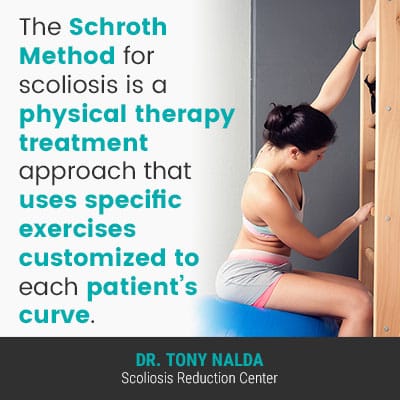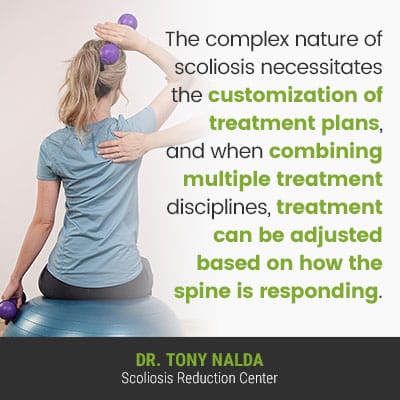It’s important for patients to be aware of all treatment options available to them because different approaches offer different potential outcomes. Although scoliosis is incurable, it is highly treatable, but only proactive treatment that impacts the condition on every level can achieve corrective results.
There are different ways to treat scoliosis, both surgically and non-surgically. The Schroth Method is a physical therapy approach to treating scoliosis by focusing on restoring muscle symmetry, breathing patterns, and postural awareness.
Let’s start our discussion of the Schroth Method by first defining scoliosis and the parameters that have to be met to reach a scoliosis diagnosis.
What is Scoliosis?
The spine’s natural and healthy curves make it stronger, more flexible, and better able to absorb/distribute mechanical stress, like a coiled spring.
There are many different types of spinal conditions that involve a loss of its healthy curves, and this can disrupt the biomechanics and function of the spine.
Scoliosis is the development of an unnatural sideways spinal curve, with rotation and a minimum Cobb angle measurement of 10 degrees.
It’s the rotational element that makes scoliosis a 3-dimensional condition as the spine doesn’t just bend unnaturally to the side but also twists.
A patient’s Cobb angle is determined during X-ray and involves drawing intersecting lines from the tops and bottoms of the most-tilted vertebrae (bones of the spine) at the apex of the curve; the resulting angle is expressed in degrees and classifies conditions by severity:
- Mild scoliosis: Cobb angle measurement of between 10 and 25 degrees
- Moderate scoliosis: Cobb angle measurement of between 25 and 40 degrees
- Severe scoliosis: Cobb angle measurement of 40+ degrees
- Very-severe scoliosis: Cobb angle measurement of 80+ degrees
The higher the Cobb angle, the more severe the condition, and the more likely it is to cause noticeable symptoms; in children and adolescents, the main symptom is postural deviation, and in adults, it’s pain.
Scoliosis is progressive, meaning it has it in its nature to worsen over time, which is why where a scoliosis is at the time of diagnosis is not indicative of where it will stay. Mild scoliosis can easily progress to moderate, severe, and very severe, especially if left untreated or not treated proactively.
Only proactive treatment can stop scoliosis from progressing, and as a progressive condition, the best time to start treatment is always now.
Now that we’ve defined the condition and explored the parameters that must be met to diagnose scoliosis, let’s move on to defining the Schroth Method for scoliosis.
What is the Schroth Method for Scoliosis?

The Schroth Method for scoliosis is a physical therapy treatment approach that uses specific exercises customized to each patient’s curve.
The Method is a non-surgical treatment option that works towards returning the scoliotic spine to a more natural position, and the goal of Schroth exercises is to elongate, de-rotate, and stabilize the spine in all three dimensions; remember, scoliosis is a 3-dimensional condition.
Schroth’s physical therapy focuses on restoring muscle asymmetry and spinal alignment, teaching patients to breathe into the concave side of their body (rotational angular breathing), and postural awareness, mainly through the use of mirrors.
The Schroth method is a long-term form of treatment that requires a full commitment as patients have to perform the exercises daily at home, and if not performed precisely as prescribed or for the length of time needed, they will be ineffective.
The length and intensity of treatment will be case-specific, with typical sessions running from 45 minutes to an hour, performed daily for up to five months or more; again, each case is unique.
Particularly when talking about the condition’s most-prevalent form, adolescent idiopathic scoliosis (AIS) diagnosed between the ages of 10 and 18. It can be difficult for these adolescents to commit to the course of treatment.
If the Schroth Method successfully reduces a curve, efforts have to continue to sustain those results.
Now that we’ve discussed the Schroth Method, let’s move on to a similar but less lengthy method that I like to use: SEAS.
What is SEAS?
SEAS stands for the Scientific Exercises Approach to Scoliosis, and like the Schroth Method, it focuses on the power of scoliosis-specific exercise to impact the condition.
SEAS uses self-correction techniques performed without the use of equipment that is customized to address the specifics of the patient and their condition.
The main goal of SEAS is improving spinal stability and using scoliosis-specific exercises (SSEs) to train neuromotor function to stimulate by reflexes, a self-corrected posture, and a more natural body positioning.
SEAS can be performed on an outpatient basis two to three times a week for approximately 45 minutes a session and can also be performed at home for around 20 minutes a day, accompanied by an intense physiotherapy session of 1.5 hours every few months.
So one of the main differences between the Schroth Method and SEAS is the length of sessions and the duration of treatment, and as SEAS is a more flexible approach that’s not as lengthy, it tends to see better results in terms of compliance, particularly when talking about adolescent patients.
The reality is that most cases of scoliosis can be treated non-surgically, and my treatment approach combines SEAS with other forms of proactive treatment to impact the condition on every level for the best potential results.
Proactive Conservative Treatment
Here at the Scoliosis Reduction Center®, I use a conservative chiropractic-centered treatment approach that involves integrating multiple treatment disciplines that complement one another and work together to reach corrective results.
As a progressive condition, scoliosis is incurable, but it is highly treatable, and in the context of scoliosis, corrective results mean impacting the condition, first and foremost, on a structural level, in the form of a curvature reduction and using SSEs to increase core strength, so the spine is optimally supported.

The complex nature of scoliosis necessitates the customization of treatment plans, and when combining multiple treatment disciplines, treatment can be adjusted based on how the spine is responding.
While I rely on the use of exercise and physical therapy for certain aspects of treatment, relying on only one form of treatment, as in the Schroth Method, or when only using SEAS, will fall short when it comes to impacting scoliosis on every level.
Firstly, I want to reduce the curvature on a structural level, and I work towards this through a series of chiropractic adjustments and techniques that can reposition the most-tilted vertebrae of the curve back into alignment with the rest of the spine.
Once I start to see structural results, I shift the focus to physical therapy and the use of SSEs to increase core strength so the muscles surrounding the spine can provide it with optimal support; I also use SEAS to address muscle asymmetry.
In addition, SSEs can activate certain areas of the brain for improved brain-body communication, postural remodeling, and a more-natural body positioning.
When necessary, I use corrective bracing to augment corrective results by pushing the spine into a corrective position.
With a series of custom-prescribed exercises, a home-rehabilitation program can be established to further stabilize the spine for sustainable long-term results.
The intensive treatment program here at the Center is one that patients can benefit from as they have access to multiple forms of treatment under one roof, and working on different levels of the condition simultaneously by combining multiple forms of treatment yields better results and compliance rates.
Conclusion
The Schroth Method for scoliosis is a physical therapy approach to scoliosis treatment that uses customized exercises to restore muscle asymmetry, practice rotational angular breathing, and teach postural awareness.
While the Schroth Method is an approach that can produce positive results, it’s a lengthy and intense regimen of home exercises that have to be performed as prescribed to work as intended, and compliance can be a challenge.
Part of the reason the Schroth Method is slow to produce results is because it’s only using one form of treatment; when scoliosis is treated with the combination of multiple treatment disciplines, different aspects of the condition are targeted simultaneously for the best potential results.
SEAS (scientific exercises approach to scoliosis) is a similar approach to the Schroth Method, and when combined with chiropractic care, corrective bracing, and a rehabilitation program, it can impact the condition on every level, from improving the structure of the spine to increasing core strength and stabilizing the spine through rehabilitation.
The integration of multiple forms of treatment that can be apportioned accordingly and adjusted throughout the course of treatment, based on how the spine is responding, is necessary as relying on only one form can’t impact the condition on every level.




